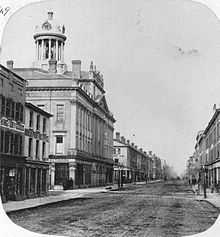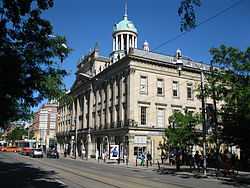St. Lawrence Hall
St. Lawrence Hall is a meeting hall in Toronto, Canada immediately north of the St. Lawrence Market. It was built on King Street East, close to the 'new city hall' - which was on the south side of Palace (now Front) Street - in 1850 after an 1849 fire destroyed much of the market. The Renaissance Revival style building was designed by William Thomas. It was created to be Toronto's public meeting hall home to public gatherings, concerts, and exhibitions. Its main feature was a thousand seat amphitheater. For decades the hall was the centre of Toronto's social life. It was here that prominent politicians such as John A. Macdonald and George Brown (fathers of Canadian Confederation) addressed the people of Toronto. It was the main venue for musicians and other performers who came to the city. The lower levels were integrated into the market and were home to stores and businesses. A third storey section of the building was known as St. Patrick Hall, an important meeting place for the Irish Catholic Benevolent Union.
By the 1870s the growing city had a number of larger and more suitable performance venues and the Hall entered a long decline. It continued to serve a number of roles, including several years as the home of the National Ballet of Canada. The city of Toronto fully restored the hall in 1967 to mark the Canadian Centennial. That same year it was designated as a National Historic Site of Canada.[1][2] The first two Juno Awards ceremonies were presented here in 1970 and 1971.
Today the hall continues as a venue for events including weddings, conferences, and art shows. A remote detonated explosion, standing in for the groundbreaking of Canada's Wonderland theme park in the York Region town of Maple, took place from the Hall.[3]
Architect and architecture

St. Lawrence Hall in 1860
William Thomas (c.1799-26 December 1860) was an architect of both England and Canada. He immigrated to Toronto with his wife and 10 children from Leamington Spa, England due to the economic crisis in 1837. After his emigration to Toronto, his career as a city engineer and architect prospered. One of his well-recognized successful works in architecture after his settlement is St. Lawrence Hall.
Thomas’ work was undoubtedly influenced by 16th-century Italian Renaissance architecture, the central Roman temple that consists of the pediment, four engaged Corinthian columns, and the three arches underneath very closely resemble the work of an Italian Classist architect, Andrea Palladio. The symmetrical composition of building elements is also a defining characteristic of Renaissance architecture. The Renaissance Revival was a clear goal of William Thomas, but the Hall reinterpreted the Italination in a vernacular and contemporary manner. St. Lawrence Hall is designed in a Victorian composition with a French mansard roof due to abundant snowfall in Ontario. The ornamental cupola on top of the main hall is another feature of the Hall.
See also
References
- ↑ St. Lawrence Hall, Directory of Designations of National Historic Significance of Canada
- ↑ St. Lawrence Hall, National Register of Historic Places
- ↑ Cowan, James (September 2001). "View to a thrill". Toronto Life.
External links
|
|---|
| | Sports venues | |
|---|
| | Cultural | |
|---|
| | Amusement | |
|---|
| | Parks and squares | |
|---|
| | Shopping | |
|---|
| | Institutional and infrastructure | |
|---|
| | By type | |
|---|
| Italics indicate structures now defunct or demolished. |
|
|
|---|
| | Provinces | |
|---|
| | Territories | |
|---|
| | Other countries | |
|---|
|
-
 Category Category
-
 Portal Portal
-
 WikiProject WikiProject
|
|

